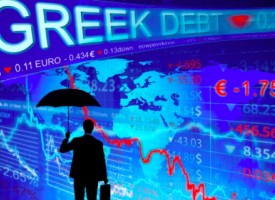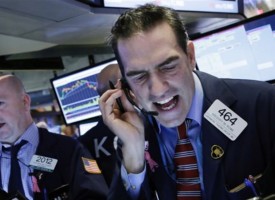On the heels of the Dow tumbling nearly 1,500 points in another day of panicked trading, 7 time Graham & Dodd Award winner and Chairman of Research Affiliates, Rob Arnott, warned 1 million people are infected with the Coronavirus and 30,000 have already died from this pandemic.
 Legend Rob Arnott, whose firm oversees $200 billion globally, warns 1 million infected with Coronavirus.
Legend Rob Arnott, whose firm oversees $200 billion globally, warns 1 million infected with Coronavirus.
Massive Coronavirus Pandemic Economic Impact
March 12 (King World News) – Eric King: “Rob, this Coronavirus situation, we don’t know if this is a bioweapon but we certainly know there is economic impact. Can you talk about this pandemic and the economic impact as you see it? Because before we kicked off this interview I showed you a chart King World News published that Chinese car sales have crashed 80%, so the economic impact is obviously real.”
China Car Sales Crash 80% Since Virus Outbreak!

1,000,000 People Infected With Coronavirus
Robert Arnott, Chairman of Research Affiliates: “Yeah, the economic impact is real and it’s not limited to China. It’s early days yet and I’m not a medical expert, so who knows how the Coronavirus will play out in terms of the pandemic? My personal guess is that it will be milder than people’s worst fears. But there’s just under 100,000 reported cases, and the reasonable assumption is that there is 10 unreported cases for every one that’s reported. Some people come down with flu like symptoms and they stay home and unless it gets critical they aren’t going to go to the hospital. And if you are in China and you go to the hospital there is no room for you and you are sent away anyway.
So if it’s a 10/1 ratio, then there are 1 million people infected, not 100,000. And there might be 30,000 deaths, instead of 3,000. But I’m not trying to be alarmist. The ordinary flu kills 250,000 to 500,000 people each year worldwide anyway, and 20,000 to 80,000 in the US. So these numbers, while they sound huge, actually aren’t that huge, yet. And the question, the unknowable, is, are the numbers going to get huge?

Paralysis Of Supply Chains
Now, where it gets interesting is the economic impact and market impact. People are finally waking up to the fact that the economic impact is huge. Whether this turns out to be something less than the ordinary seasonal flu or something as virulent as the Spanish Flu of 1918, the economic impact is much the same in either case, and that is paralysis of supply chains. Now the flip side of a supply chain is money is not available to be paid and so bankruptcies soar and defaults soar. And quality spreads should be blowing out but they are not. So, that’s interesting.
The other part of it that’s interesting is the capital markets implications because people think, ‘Oh my goodness, this is going to be horrible for stock markets around the world.’ Not necessarily. I’m hedging my bets here a bit because anything can and does happen in the capital markets. But if people aren’t spending, they’re keeping their money somewhere and some of that will just naturally go into the liquid capital markets — stocks and bonds. The tumbling of the interest rates also takes the lid off the riskier assets to some extent — the Fed put is very much alive and well.

Impact On Global Markets
So the impact on the capital markets is uncertain, but could actually be positive, not negative. The interesting comparison and the comparison everybody uses is the 1918 Spanish Flu pandemic. It’s kind of a misnomer. It didn’t come from Spain but Spain was the only country that was reporting accurate statistics because it was the tail end of World War I and nobody was going to report anything that would be alarming. So Spain was one of the only countries that reported it, hence the name. But that pandemic did in fact kill 50,000,000 to 100,000,000 million people back when the world’s population was only 1.5 billion. So that’s horrific. The damage in the US: More soldiers died returning from World War I with Spanish Flu than died in World War I. Wow!
Do Not Buy US Stocks
So this kind of impact is very significant and yet what happened to the US stock market (in 1918)? It just got a little more volatile, chopped up and down a bit, and a year later was materially higher. So markets move based on flows of capital, and flows of capital are driven in part by fundamentals but they are also driven in part by what you are doing with your money. And if you are not spending it you are probably putting it away somewhere. So this doesn’t have to be bad for stocks. Now does that mean I’m a buyer of US stocks? No! You mentioned Stephanie Pomboy’s wonderful graph (published by KWN) showing the US market capitalization relative to GDP — recently the highest in history, including the tech bubble.
Even After Pullback, Stock Market
At 2nd Highest Valuation In History!

Everyone Needs To Listen To This Interview
Now, after this dip, US market capitalization relative to GDP is at the second highest level ever, just barely under what it was at the peak of the tech bubble. Well, that’s not bargain territory…To listen to one of the most important interviews of 2020 with Robert Arnott discussing the wild trading in stocks, bonds, and global markets, as well as where he is investing over half of his liquid net worth right now CLICK HERE OR ON THE IMAGE BELOW.
© 2020 by King World News®. All Rights Reserved. This material may not be published, broadcast, rewritten, or redistributed. However, linking directly to the articles is permitted and encouraged.








